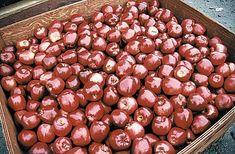
Canadian researchers analysing eight varieties popular in the country found that the old standby, Red Delicious, and an apple called Northern Spy contain more disease-fighting antioxidants in their skin and flesh than any other studied.
Red Delicious had more than twice the antioxidant activity as Empire, which had the least activity of the eight.
"Choosing an apple with a high proportion of polyphenols (natural chemicals that cause tissue to contract) in the flesh and skin can potentially produce more health benefits," said Rong Tsao, lead author of the study appearing in the Journal of Agricultural and Food Chemistry on June 29, and published online last week. "But eating any apple is better than eating no apple at all."
Tsao also pinpointed the individual compounds most responsible for antioxidant activity in apples. Their findings could lead to breeding of hybrid apples that pack an even more potent punch.
Polyphenyls are a major source of antioxidants in apples, but researchers have not been sure just which of these chemicals are most active. Another researcher, Riu Hai Liu of Cornell University, has found that eating 100 grams of apple provides the same amount of antioxidant activity as taking 1,500 milligrams of vitamin C, but that vitamin is present in apples in only small amounts.
Polyphenyl activity in apples was researched in Red Delicious, McIntosh, Cortland, Northern Spy, Idared, Golden Delicious, Mutsu and Empire. All the apples used in the study were grown on the same Ontario farm under similar conditions.
It was five times more prevalent in the skin than the flesh of the apples. Northern Spy had a little less of the compounds in its skin than Red Delicious, but about twice as much in the flesh of the fruit than Red D.



